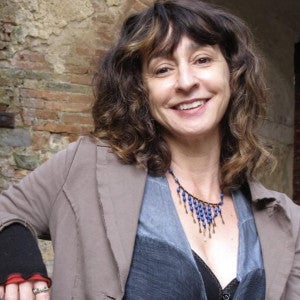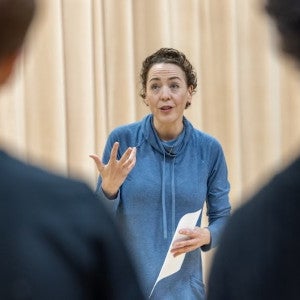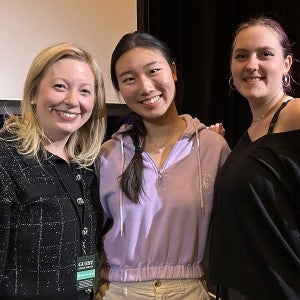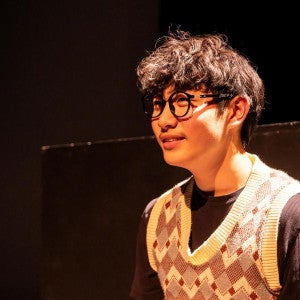Decoding the universe: Mikky Davey brings math to life for young artists
From 3D printers to building custom AIs for her students, Davey is constantly innovating in the Arts Academy classroom. An early love of math has developed into her lifelong passion—and a unique gift for making math understandable and fun for artistic students.
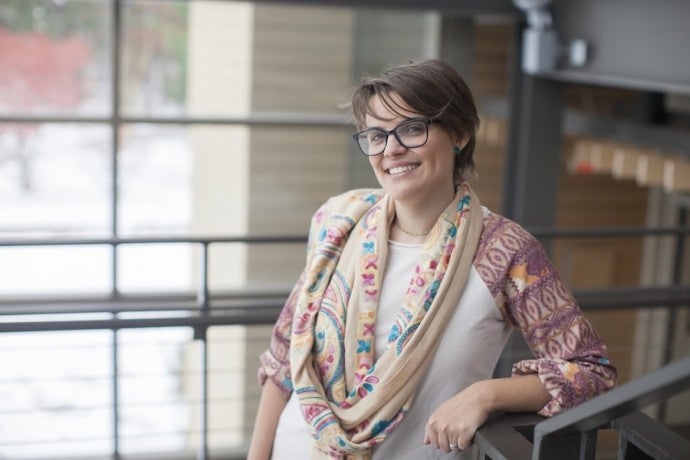
Instructor of Mathematics Michelle “Mikky” Davey has always had a unique way of looking at the world. It might have started with her nomadic childhood spent in the woods of Michigan’s Upper Peninsula. It might have been the time she spent educating her siblings, or her early sense of math’s beauty in all its patterns and logical structure. However she came to possess it, Davey brings a spirit of adventure, innovation, and creativity to her work with students at Interlochen Arts Academy.
From teaching her siblings to teaching as a career
Step into Davey’s classroom, and you’ll find it buzzing with electric energy and anticipation. It’s no wonder—the woman who leads it is extremely passionate about what she does. At Arts Academy, Davey runs a 3D printing club, teaches classes in logic and programming, and helps her students explore computer science through video game design projects. In her spare time, she attends tech conferences and other professional development opportunities (she recently returned from one put on by Learning and the Brain).
Davey’s deep love of math goes back to her childhood. Homeschooled for most of her life, she grew up exploring the forest and teaching various subjects to her siblings out of textbooks purchased at Sam’s Club. She didn’t see the inside of a school until freshman year, when the colors and patterns of her teacher’s Algebra I presentations dazzled her mind and captured her attention.
“At that point, I decided I wanted whatever this was,” she remembers. “I wanted to be part of it, understand it, and show it to people.”
In college she marveled even further when she watched a calculus classmate use equations to build the shape of a vase. Davey soon chose to major in secondary mathematics education. She didn’t just want to learn more about math—she wanted to share it with others.
“ I fell in love with the structure and beauty of mathematical thinking and how it can make chaos feel ordered. Teaching was just a way for me to offer what I understood to other people.”
Davey graduated from Ferris State University just as Interlochen Arts Academy was in the process of looking for a new math teacher. When she set foot on campus for an interview, she was immediately sold.
“I arrived and immediately realized this was where I was supposed to be,” she reflects. “ I think some of it was the tall pines that reminded me of my childhood in the U.P. campgrounds. It felt like home.”
Teaching math to artists
Since starting her job beneath the stately pines in 2016, Davey has continued to propel change in the classroom: she was the first to teach programming lessons at Interlochen, and she helped lead the charge in securing several 3D printers for academic use. Her class, Advanced Math: Logic and Programming, allows her to explore new ideas right alongside her students. She co-teaches the class with instructors from MIT and Stanford, who Zoom in for most meetings.
“ We take our students through learning how to program, programming logic, and some basic Python. Then we introduce them to artificial intelligence as math prediction models, teaching them how to make a linear regression or a line. That helps us unlock the very basis of AI,” she says.
Davey tailors her teaching to meet the needs of artistically-inclined students, many of whom are seeking careers in creative fields.
“A lot of my students are initially unsure whether programming is something they can do,” she comments. “But once they get into it and see the structure and the logic of it, and realize that it’s within their wheelhouse, they go crazy for it.”
She says students at an arts school tend to be perfectionistic, always focused on achieving the correct outcome. The minute they step into her classroom, that mindset has to go.
“When we solve problems, we are solving puzzles,” she explains. “We're trying to understand the world around us and how it can communicate to us, because math is the language of our universe.”
Davey frequently relies on visual means to make math come to life for her students. She has her students create their own scrapbook-style “textbooks” for class, which can be as colorful as they are informative. She also uses 3D printers to create shapes that students can see and feel.
“We do several 3D printing projects when we’re learning about geometry and visualization. The printers provide a physical way for students to play with the models they see in their minds.”
These visual and kinetic tools have proved to be incredibly effective. Over time, she’s watched many of her most hesitant students become hungry to learn more about the intersections between math and technology.
“Advanced Math is a one semester course, but by the end of it, they've learned skills and made artistic connections that go way beyond what I could teach them on my own. It's always impressive.”
When we solve problems, we are solving puzzles. We're trying to understand the world around us and how it can communicate to us, because math is the language of our universe.
Innovation takes the wheel
As Davey invests in each of her students, she’s constantly looking for ways to improve their learning experience. Right now, she’s building a custom AI for classroom use. The finished program will align with Davey’s personal teaching philosophy and be able to provide students with guidance based on their personalized learning plans.
She also stays abreast of educational research. Her latest explorations, based on work done by the HeartMath Institute, suggest that students learn best when their nervous systems are relaxed.
“Your brain’s amygdala is controlled by the rhythms and resonance of your heartbeat, which means if you are not in a stable, predictable rhythm in the classroom, you can't learn,” she notes. “I teach my students to calm down and breathe through things that are complicated and confusing.”
No matter what she’s doing to enhance her students’ experience, Davey stays motivated by the bright young minds in her classes.
“The students themselves are my main motivator,” she says. “They care so much about learning, about themselves, and about the world. They're so willing and interested. Any time spent with them is always rewarding.”
For Davey, the discipline of learning math is so much more than quadratic equations and trigonometry. It’s a chance to explore the limits that define our world and everyday lives.
“As students are developing and finding out who they are as individuals, I want to offer them a way to structure ideas, make sense of what’s happening around them, and even understand how their own brains work,” says Davey. “It’s my joy and privilege to share the language of mathematics with my students, and I look forward to continuing to do that for as long as I can.”
Students at Interlochen Arts Academy enjoy world-renowned artistic training from gifted professionals alongside college-preparatory academics. Learn more about Interlochen Arts Academy.

